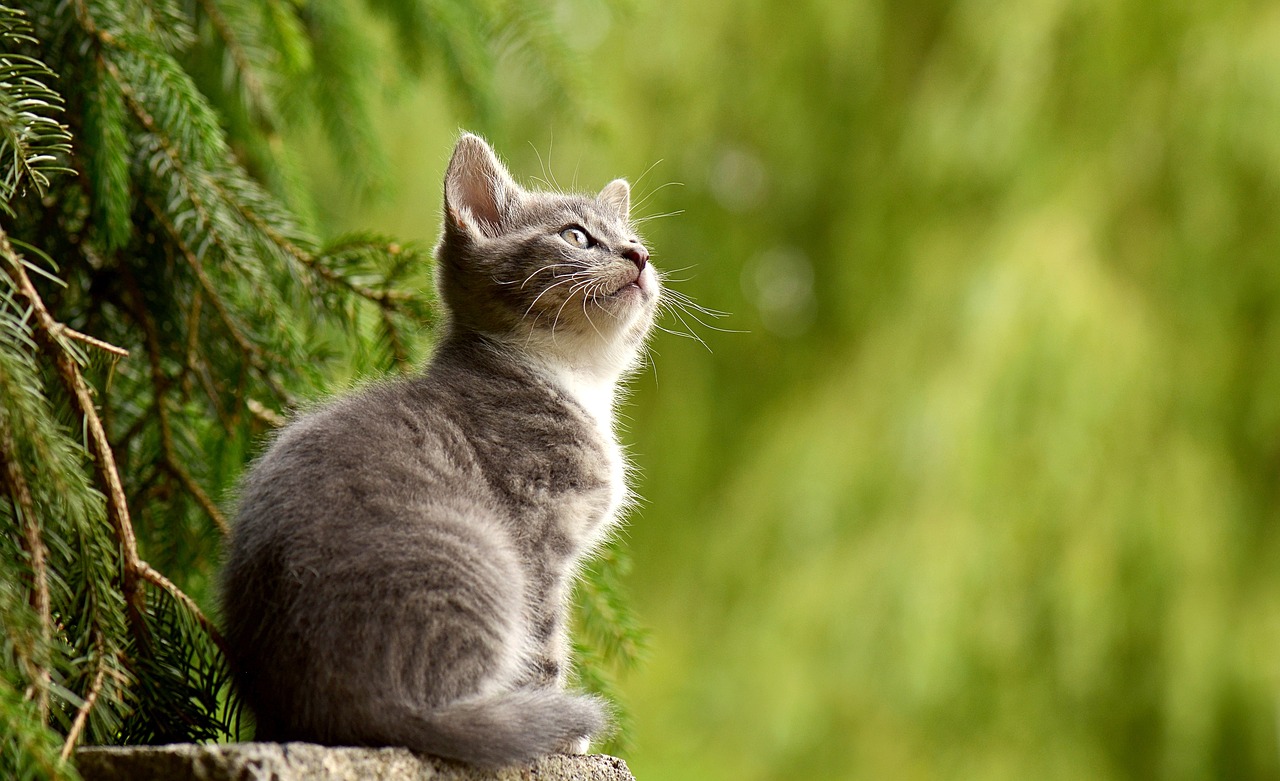Tips for Socializing Your Cat
This article provides essential strategies for effectively socializing your cat, ensuring they become well-adjusted and friendly companions. Discover techniques to improve their interactions with people and other pets.
To socialize your cat effectively, it’s crucial to understand their natural behaviors and instincts. Cats are inherently independent creatures, often valuing their personal space. By learning about their body language and vocalizations, you can create a comfortable environment that encourages positive interactions. For instance, did you know that a cat's tail position can tell you a lot about their mood? A raised tail usually indicates happiness, while a tucked tail suggests fear or anxiety. Understanding these signals can help you tailor your approach to suit your feline friend.
Establishing a safe, quiet area for your cat is vital during the socialization process. This space allows them to retreat when feeling overwhelmed, promoting a sense of security. Think of it as their personal sanctuary, a cozy nook where they can feel at ease. You can create this safe space by choosing a quiet corner of your home, away from the hustle and bustle of daily life. Adding soft bedding, toys, and even a few treats can make this area inviting and comforting.
Selecting an appropriate location for socialization sessions can significantly impact your cat's comfort level. Consider quiet, low-traffic areas to minimize distractions and stress. If you have multiple rooms, try to find a space that feels enclosed yet accessible. This will help your cat feel secure while also allowing them to observe the world around them without feeling overwhelmed.
Loud noises can frighten cats and hinder their socialization. Ensure the environment is calm and peaceful, using soft music or white noise to mask sudden sounds. You might be surprised how much a little background noise can help. It creates a soothing atmosphere that can ease your cat's anxiety, making them more receptive to new experiences.
Offering hiding spots, such as boxes or cat trees, gives your cat a place to retreat when feeling anxious. This encourages exploration at their own pace. Cats are naturally curious, but they also need to feel safe. By providing small, enclosed spaces, you allow them to venture out when they feel ready, promoting confidence and curiosity.
Introducing your cat to new people and pets should be a gradual process. Slowly increasing exposure helps reduce anxiety and fosters positive associations with social interactions. Start with short visits from friends or family members, allowing your cat to approach them on their own terms. This way, they can sniff, observe, and get comfortable without feeling pressured.
Positive reinforcement is an effective tool for encouraging desired behaviors in your cat. Rewarding them with treats or praise can help build confidence during socialization. When your cat interacts positively with a new person or pet, shower them with affection and tasty treats. This creates a positive association that they will remember, making future interactions smoother and more enjoyable.
Incorporating treats into socialization sessions can motivate your cat to engage with new experiences. Choose high-value treats that your cat loves to increase their willingness to participate. For example, if your cat goes to greet a visitor, reward them immediately with a tasty treat. This not only encourages the behavior but also reinforces their bravery in exploring new social settings.
Playtime is a fantastic way to bond with your cat while promoting social skills. Interactive toys can stimulate their instincts and encourage them to engage with you and others. Whether it's a feather wand or a laser pointer, playtime is not just fun; it's a way for your cat to learn how to interact positively with both humans and other pets.
Keeping track of your cat's socialization progress is essential. Observing their reactions helps you adjust your approach and ensure they are comfortable with each step. Consider keeping a journal of their interactions, noting what works and what doesn’t. You'll be amazed at how quickly they can adapt when given the right environment and encouragement.
Being aware of stress signals, such as hiding or hissing, allows you to respond appropriately. If your cat shows signs of distress, it may be time to slow down the socialization process. Remember, every cat is unique, and what works for one may not work for another. Patience is key!
Acknowledging and celebrating small milestones in your cat's socialization journey can encourage further progress. Every positive interaction is a step towards a more sociable feline companion. Whether it's a gentle purr or a playful swipe at a toy, these small victories deserve recognition. Celebrate them with extra cuddles or a special treat!
- How long does it take to socialize a cat? The duration varies by cat, but patience and consistency are essential. Some cats may take weeks, while others may take months.
- Can older cats be socialized? Absolutely! While it may take more time, older cats can learn to enjoy social interactions with the right approach.
- What if my cat continues to show signs of stress? If your cat is consistently stressed, it may be beneficial to consult with a veterinarian or a feline behaviorist for tailored advice.

Understanding Cat Behavior
To socialize your cat effectively, it’s crucial to understand their natural behaviors and instincts. Cats are fascinating creatures, often misunderstood due to their independent nature. While they may seem aloof, they actually have a rich emotional life and specific social needs. By taking the time to learn about these behaviors, you can create a comfortable environment that encourages positive interactions. For instance, did you know that cats communicate primarily through body language? A flick of the tail or a slow blink can convey a myriad of emotions, from affection to annoyance. Understanding these signals is key to fostering a strong bond with your feline friend.
Additionally, it’s important to recognize that every cat has its own personality. Some may be naturally more sociable, while others might be more reserved. This variation can be influenced by factors such as genetics, early experiences, and even their breed. For example, breeds like the Ragdoll and Maine Coon are often more outgoing, while Siamese cats can be quite vocal and demanding of attention. By observing your cat's unique behavior, you can tailor your socialization strategies to fit their individual needs.
Moreover, socialization isn’t just about introducing your cat to new people or pets; it’s also about helping them feel secure in their environment. Cats are territorial by nature, and any changes in their surroundings can cause stress. This is why creating a safe space is essential. A safe space allows your cat to retreat when they feel overwhelmed, promoting a sense of security that is vital for their overall well-being. Consider incorporating elements such as:
- Soft bedding in a quiet corner
- Favorite toys that provide comfort
- Vertical spaces like shelves or cat trees for climbing and observing
Understanding cat behavior also means recognizing their playfulness. Play is not just a fun activity; it’s a crucial part of their social development. Engaging your cat in playtime helps them to express their natural hunting instincts while also strengthening your bond. Use interactive toys like feather wands or laser pointers to stimulate their interest and encourage them to interact with you.
In conclusion, understanding your cat's behavior is the first step towards successful socialization. By observing their body language, recognizing their unique personality traits, and providing a safe and stimulating environment, you can help your cat become a well-adjusted and friendly companion. Remember, patience is key; socialization is a journey, not a sprint. Celebrate each small victory along the way, and your efforts will surely pay off in the form of a happier, more sociable feline.

Creating a Safe Space
Establishing a safe, quiet area for your cat is vital during the socialization process. Think of this space as your cat's personal sanctuary, a cozy nook where they can feel secure and relaxed. Cats, being naturally cautious creatures, often seek refuge when they feel overwhelmed. By providing a designated area, you’re essentially giving them a safe harbor amidst the chaos of social interactions. This not only promotes a sense of security but also encourages them to explore their environment at their own pace.
When creating this safe space, consider the following elements:
- Comfortable Bedding: Ensure the area has soft bedding, like a plush blanket or a cat bed, where your feline friend can curl up and feel at ease.
- Access to Essentials: Place their food, water, and litter box nearby to minimize the need for them to venture out when they’re feeling shy.
- Personal Items: Include toys or items that smell like you to make the space even more comforting. Familiar scents can significantly reduce anxiety.
Moreover, the location of this safe space is crucial. Selecting an appropriate spot for socialization sessions can significantly impact your cat's comfort level. Ideally, you want to choose quiet, low-traffic areas that minimize distractions and stress. Think of it as setting up a cozy café for your cat, where they can sip their favorite drink (or, in this case, munch on treats) without the hustle and bustle of the outside world interrupting their peace.
Loud noises can frighten cats and hinder their socialization. Imagine how you would feel trying to have a conversation in a noisy bar; it’s just not conducive to a pleasant experience. To create a serene environment, ensure the area is calm and peaceful. You might consider using soft music or white noise to mask sudden sounds that could startle your cat. This can create a soothing backdrop that encourages relaxation and exploration.
Offering hiding spots, such as boxes or cat trees, gives your cat a place to retreat when feeling anxious. Think of these hiding spots as their personal fortresses, where they can observe the world from a safe distance. Cats are naturally curious, but they also need the option to hide when they feel overwhelmed. This encourages exploration at their own pace, allowing them to gradually become comfortable with new experiences and interactions.
In summary, creating a safe space for your cat is about more than just providing shelter; it’s about fostering an environment that encourages exploration, comfort, and security. By paying attention to their needs and preferences, you can help them thrive socially while also nurturing their natural instincts.
- How long should I keep my cat in their safe space? It varies by cat; some may need a few days, while others might take weeks. Monitor their comfort level and gradually introduce them to new experiences.
- Can I use a room as a safe space? Absolutely! A quiet room can be a perfect safe space, just ensure it has all their essentials.
- What if my cat refuses to leave their safe space? Be patient. Encourage them gently with treats and playtime, but don’t force them out. They'll explore when they feel ready.
Choosing the Right Location
When it comes to socializing your cat, the location where you conduct these interactions plays a pivotal role in your feline friend's comfort level. Think of it like setting the stage for a play; the right environment can make all the difference in the performance! Ideally, you want to choose a space that is quiet and low-traffic, minimizing distractions that could overwhelm your cat. A serene setting allows your cat to focus on the new experiences without feeling the pressure of excessive noise or movement.
Consider areas in your home that are away from the hustle and bustle of daily life. For instance, a cozy corner in your living room or a spare bedroom might be just the ticket. The key is to create a space that feels safe and secure for your cat, where they can explore at their own pace without feeling cornered or threatened.
Additionally, you might want to incorporate elements that promote relaxation. Soft lighting, comfortable bedding, and even some gentle background music can help set the mood. Cats are sensitive to their surroundings, and a calming atmosphere can significantly enhance their willingness to engage. You can also consider the following:
- **Natural Light:** Cats love to bask in the sun. A well-lit area can make them feel more at ease.
- **Avoid High Places:** While cats enjoy climbing, having too many high spots can make them feel trapped. Ensure there are accessible spots for them to retreat to.
- **Familiar Scents:** Using their favorite blanket or toys can create a sense of familiarity and comfort.
Remember, the goal is to foster a positive experience for your cat. By thoughtfully choosing the right location, you're not just providing a physical space; you're creating an environment that encourages trust and confidence. This careful consideration can lead to more successful socialization sessions, paving the way for your cat to become a well-adjusted and sociable companion.
Minimizing Loud Noises
When it comes to socializing your cat, one of the biggest hurdles can be the presence of loud noises. Cats are naturally sensitive creatures, and unexpected sounds can send them scurrying for cover faster than you can say "treat!" To create a welcoming environment for your feline friend, it’s essential to take steps to minimize these disruptive sounds. Imagine your cat as a delicate flower; too much noise can easily wilt their confidence and make them retreat into their shell.
Start by identifying potential sources of noise in your home. Is the television blaring? Are there loud appliances running? Even the sound of children playing can be overwhelming for some cats. Here are some strategies to help create a serene atmosphere:
- Use Soft Music: Playing gentle, calming music can help drown out harsher sounds. There are even playlists designed specifically for pets!
- White Noise Machines: Consider investing in a white noise machine. These devices can create a consistent sound that masks sudden loud noises, providing a more stable environment for your cat.
- Soundproofing: If possible, try to soundproof the area where your cat spends most of their time. Adding rugs, curtains, or even acoustic panels can help absorb noise.
It’s also important to be mindful of your own behavior. If you’re a fan of loud music or enjoy hosting raucous gatherings, consider how this might affect your cat. During socialization sessions, aim to keep the volume down and encourage a calm atmosphere. Think of it as creating a cozy café vibe, where your cat feels relaxed and at ease.
Remember, the goal is to foster a space where your cat feels safe and secure enough to explore and engage. By minimizing loud noises, you’re not just helping them adjust to their surroundings; you’re also laying the groundwork for positive social interactions. So, take a deep breath, turn down the volume, and watch as your cat slowly blossoms into the social butterfly you know they can be!
- How can I tell if my cat is stressed by noise?
Look for signs like hiding, excessive grooming, or vocalizing. If your cat seems anxious, it may be time to reassess your environment. - What types of music are best for calming cats?
Soft classical music or specially designed pet playlists can be soothing for your cat. - Is it okay to let my cat hide if they feel scared?
Absolutely! Providing a safe space for your cat to retreat to when feeling overwhelmed is essential for their comfort.
Providing Hiding Spots
This article provides essential strategies for effectively socializing your cat, ensuring they become well-adjusted and friendly companions. Discover techniques to improve their interactions with people and other pets.
To socialize your cat effectively, it’s crucial to understand their natural behaviors and instincts. This knowledge can help you create a comfortable environment that encourages positive interactions.
Establishing a safe, quiet area for your cat is vital during the socialization process. This space allows them to retreat when feeling overwhelmed, promoting a sense of security.
Selecting an appropriate location for socialization sessions can significantly impact your cat's comfort level. Consider quiet, low-traffic areas to minimize distractions and stress.
Loud noises can frighten cats and hinder their socialization. Ensure the environment is calm and peaceful, using soft music or white noise to mask sudden sounds.
Every cat is unique, and one of the best ways to make them feel secure during the socialization process is by providing hiding spots. Cats are naturally inclined to seek refuge when they feel threatened or anxious. By creating cozy nooks and crannies, you allow your feline friend to have a safe haven where they can retreat and observe their surroundings without feeling overwhelmed.
Consider using a variety of materials and locations for these hiding spots. For instance, you can:
- Place cardboard boxes around your home—cats love to curl up in them.
- Invest in cat trees that provide elevated hiding spaces.
- Utilize blankets or soft cloths draped over furniture to create makeshift caves.
These hiding spots not only give your cat a sense of security but also encourage them to explore their environment at their own pace. It’s like giving them a personal fortress where they can feel in control. When they are ready, they will emerge from their hiding spots, becoming more curious and engaged with their surroundings.
Moreover, it’s essential to observe how your cat uses these spaces. If they frequently retreat to a particular spot, it might indicate that they need more time to adjust to new experiences. By recognizing their preferences, you can tailor your approach to socialization, ensuring that it aligns with their comfort level.
Introducing your cat to new people and pets should be a gradual process. Slowly increasing exposure helps reduce anxiety and fosters positive associations with social interactions.
Positive reinforcement is an effective tool for encouraging desired behaviors in your cat. Rewarding them with treats or praise can help build confidence during socialization.
Incorporating treats into socialization sessions can motivate your cat to engage with new experiences. Choose high-value treats that your cat loves to increase their willingness to participate.
Playtime is a fantastic way to bond with your cat while promoting social skills. Interactive toys can stimulate their instincts and encourage them to engage with you and others.
Keeping track of your cat's socialization progress is essential. Observing their reactions helps you adjust your approach and ensure they are comfortable with each step.
Being aware of stress signals, such as hiding or hissing, allows you to respond appropriately. If your cat shows signs of distress, it may be time to slow down the socialization process.
Acknowledging and celebrating small milestones in your cat's socialization journey can encourage further progress. Every positive interaction is a step towards a more sociable feline companion.
Q: How long does it take to socialize a cat?
A: The time it takes to socialize a cat varies based on their personality and past experiences. Some cats may adapt within weeks, while others may take months. Patience is key!
Q: Can I socialize an older cat?
A: Absolutely! Older cats can be socialized, although it may take more time and gentle approaches. Start slowly and respect their comfort levels.
Q: What if my cat doesn’t like treats?
A: If your cat isn't motivated by treats, try using their favorite toys or even gentle petting as a reward. Every cat is unique, so find what works best for yours!
Gradual Introductions
When it comes to socializing your cat, patience is key. Cats are naturally cautious creatures, and introducing them to new people or pets should be done in a way that respects their instincts. Think of it like introducing a shy friend to a big party: you wouldn’t throw them in the middle of the crowd and expect them to thrive, right? Instead, you’d gradually ease them into the situation, allowing them to feel comfortable and secure. This gradual approach not only helps your cat adjust but also fosters a sense of trust between you and your furry friend.
Start by allowing your cat to observe new individuals or pets from a distance. This could be as simple as having a friend sit quietly in the same room, allowing your cat to approach at their own pace. Always remember to keep the initial interactions brief and positive. If your cat seems curious, reward them with treats or gentle praise, reinforcing that this new experience is a good thing.
As your cat becomes more comfortable, you can slowly decrease the distance between them and the new person or pet. However, it’s crucial to watch for any signs of stress or discomfort. If your cat starts to hide, hiss, or display any other signs of anxiety, take a step back. You might need to repeat earlier steps before moving forward again. This process of gradual exposure reinforces positive associations, making your cat more likely to accept new interactions in the future.
Consider creating a structured plan for these introductions, perhaps using a simple table to track your progress. Here’s a quick example:
| Step | Action | Duration | Notes |
|---|---|---|---|
| 1 | Observation from a distance | 5-10 minutes | Reward calm behavior with treats |
| 2 | Short interactions | 2-5 minutes | Use toys or treats to engage |
| 3 | Increased interaction time | 10-15 minutes | Monitor for signs of stress |
| 4 | Free playtime together | As comfortable | Ensure a safe environment |
Remember, every cat is unique, and what works for one may not work for another. The goal is to create a comfortable atmosphere where your cat feels safe and can explore their social boundaries at their own pace. By respecting their comfort zone and gradually introducing them to new experiences, you’re laying the groundwork for a well-adjusted and sociable companion.
- How long does it take to socialize a cat? The timeline can vary widely depending on the cat’s personality. Some may take a few weeks, while others might need several months.
- What should I do if my cat shows aggression during introductions? If your cat displays aggressive behavior, it’s important to back off and give them space. Gradually reintroduce them when they seem calmer.
- Can I use toys to help socialize my cat? Absolutely! Interactive toys can encourage play and curiosity, making the introduction process more enjoyable for your cat.
- Is it necessary to socialize my cat? While not every cat needs to be socialized, doing so can improve their quality of life and reduce stress in various situations.

Utilizing Positive Reinforcement
When it comes to socializing your cat, positive reinforcement is your best friend. Think of it as a way to communicate with your feline companion that good things happen when they engage in new experiences. By rewarding your cat for their brave attempts to socialize, you're not just teaching them to behave; you're building their confidence and trust in you. This method is like planting seeds in a garden—the more you nurture them, the more they’ll grow into beautiful, blossoming relationships with both humans and other pets.
So, how do you effectively utilize this technique? First off, it’s essential to understand what motivates your cat. Every cat is unique, and while some might be motivated by tasty treats, others may respond better to playtime or affection. Therefore, identifying your cat's favorite rewards is crucial. Here’s a quick rundown of some common motivators:
- Treats: High-value treats can be a game changer. Look for options that your cat absolutely loves, whether it's chicken-flavored bites or crunchy fishy snacks.
- Toys: Interactive toys can not only serve as a reward but also encourage play, making socialization a fun experience.
- Affection: Some cats thrive on love and attention. A gentle pet or a scratch behind the ears can be just as rewarding as a treat.
Incorporating these rewards into your socialization sessions can significantly enhance your cat's willingness to engage. Imagine this: you’re trying to introduce your cat to a new friend. As your cat approaches, you offer a treat or a favorite toy. This creates a positive association with the new person, making your cat more likely to approach them in the future. It’s all about creating a positive feedback loop—the more they interact positively, the more they want to do it again!
Another effective strategy is to use verbal praise alongside treats. Cats may not understand words the way we do, but they can definitely pick up on your tone and enthusiasm. A cheerful "Good job!" or "What a brave kitty!" can go a long way in reinforcing their good behavior. Think of your voice as a musical score that adds rhythm to your cat's learning experience.
But remember, patience is key. Socializing a cat takes time, and not every interaction will go smoothly. If your cat seems hesitant or stressed, don’t force the situation. Instead, take a step back and try again later. Celebrate those small victories, whether it's a brief sniff of a new person or a playful paw at a toy. Each step forward is a reason to cheer!
To wrap it up, using positive reinforcement is like being a cheerleader for your cat. You’re not just rewarding them for their actions; you’re building a bridge of trust and understanding that will lead to a more social and confident feline friend. So grab those treats, prepare the toys, and get ready to embark on this rewarding journey together!
Q: How long does it take to socialize a cat?
A: The timeline varies greatly depending on the individual cat's personality. Some cats may take weeks while others might take months. Patience is essential!
Q: What if my cat doesn’t respond to treats?
A: Not all cats are food-motivated. Try different types of rewards like playtime or affection. Observe what excites your cat the most.
Q: Can I socialize my cat if they are older?
A: Absolutely! While younger cats may adapt more easily, older cats can also learn to socialize. Just be sure to go at their pace and respect their comfort levels.
Q: Should I force my cat to interact with new people or pets?
A: No! Forcing interactions can lead to stress and anxiety. Always allow your cat to approach new experiences on their own terms.
Using Treats Wisely
This article provides essential strategies for effectively socializing your cat, ensuring they become well-adjusted and friendly companions. Discover techniques to improve their interactions with people and other pets.
To socialize your cat effectively, it’s crucial to understand their natural behaviors and instincts. This knowledge can help you create a comfortable environment that encourages positive interactions.
Establishing a safe, quiet area for your cat is vital during the socialization process. This space allows them to retreat when feeling overwhelmed, promoting a sense of security.
Selecting an appropriate location for socialization sessions can significantly impact your cat's comfort level. Consider quiet, low-traffic areas to minimize distractions and stress.
Loud noises can frighten cats and hinder their socialization. Ensure the environment is calm and peaceful, using soft music or white noise to mask sudden sounds.
Offering hiding spots, such as boxes or cat trees, gives your cat a place to retreat when feeling anxious. This encourages exploration at their own pace.
Introducing your cat to new people and pets should be a gradual process. Slowly increasing exposure helps reduce anxiety and fosters positive associations with social interactions.
Positive reinforcement is an effective tool for encouraging desired behaviors in your cat. Rewarding them with treats or praise can help build confidence during socialization.
Incorporating treats into your cat's socialization sessions can be a game changer! Think of treats as the gold stars of the cat world; they can turn a challenging experience into a rewarding one. When you introduce your cat to new experiences, using treats wisely can motivate them to engage and explore. Choose high-value treats that your cat absolutely adores—these are the treats that will make their eyes light up! This could be anything from crunchy kibble to soft, meaty morsels, depending on your cat's preferences.
It's essential to use treats strategically during socialization. Instead of tossing a handful of treats at once, consider the following:
- Timing: Offer treats immediately after a positive interaction to reinforce the behavior.
- Quantity: Start with small amounts to avoid overwhelming your cat and to keep them interested.
- Variety: Mix it up! Use different treats for different sessions to maintain their curiosity and excitement.
By doing this, you're not just rewarding your cat; you're creating a strong association between socialization and something they love. Imagine how much more eager they will be to meet new people or pets if they know a tasty treat awaits them!
Moreover, it’s important to observe your cat's reactions to the treats. If they seem hesitant or uninterested, it might be time to switch things up. Remember, the goal is to build confidence and trust. So, keep it fun and engaging!
Keeping track of your cat's socialization progress is essential. Observing their reactions helps you adjust your approach and ensure they are comfortable with each step.
Being aware of stress signals, such as hiding or hissing, allows you to respond appropriately. If your cat shows signs of distress, it may be time to slow down the socialization process.
Acknowledging and celebrating small milestones in your cat's socialization journey can encourage further progress. Every positive interaction is a step towards a more sociable feline companion.
Q: How long does it take to socialize a cat?
A: The time it takes can vary significantly based on the cat's personality. Some cats may take weeks, while others might need months. Patience is key!
Q: Can I use my cat's regular food as treats?
A: While you can use their regular kibble, high-value treats are often more effective during socialization because they capture your cat's attention better.
Q: What if my cat doesn't like treats?
A: If your cat isn't motivated by food, consider using praise, petting, or playtime as rewards instead. Every cat is different, so find what works best for yours!
Encouraging Playtime
Playtime is not just a fun activity for your cat; it’s a vital aspect of their socialization and overall well-being. Just like humans, cats thrive on interaction and engagement. Imagine your cat as a little athlete, ready to pounce and chase! By incorporating play into their daily routine, you can help them develop their social skills and build a stronger bond with you and other pets in the household. So, how do you create an environment that encourages play? Let's dive into some effective strategies!
First and foremost, choose the right toys. Cats are natural hunters, and their playtime should mimic that instinct. Opt for interactive toys that stimulate their senses and challenge their agility. Feather wands, laser pointers, and even simple crumpled paper balls can ignite their playful spirit. It’s fascinating to watch them stalk, pounce, and capture their “prey.” You’ll not only entertain them but also provide them with much-needed exercise.
Next, consider setting a regular playtime schedule. Cats thrive on routine, and having designated play sessions can help them anticipate and look forward to this bonding time. Aim for at least two to three short play sessions each day, lasting about 10 to 15 minutes. This frequency allows your cat to expend energy without becoming overstimulated. Remember, consistency is key! Over time, your cat will associate these moments with fun and excitement, making them more likely to engage.
Additionally, involve other family members in the play sessions. This not only helps your cat become more socialized but also strengthens the bond between your cat and other household members. Encourage gentle interactions and let your cat take the lead. If they seem overwhelmed, allow them to retreat to their safe space. Always remember that the goal is to create a positive experience that fosters trust and comfort.
To further enhance your cat's playtime, consider incorporating training exercises into the mix. Teaching your cat tricks or commands through play can be both rewarding and entertaining. Use treats as positive reinforcement to motivate them. For example, try teaching them to “high five” or “sit” during playtime. This not only stimulates their mind but also reinforces their social skills as they learn to respond to cues from you.
Lastly, don’t forget to observe your cat’s body language during play. Look for signs of enjoyment, such as a relaxed posture, playful pouncing, and purring. If your cat starts to show signs of stress or disinterest, it’s essential to take a step back. Play should always be a fun and enjoyable experience for your feline friend. By creating an engaging and safe play environment, you’re paving the way for a happier, more sociable cat.
- How often should I play with my cat? It's recommended to have at least 2-3 play sessions per day, each lasting around 10-15 minutes.
- What types of toys are best for my cat? Interactive toys like feather wands, laser pointers, and puzzle toys are great for stimulating your cat's hunting instincts.
- Can I play with my cat too much? Yes, over-stimulation can lead to stress. Pay attention to your cat's cues and allow them to take breaks.
- How can I tell if my cat is enjoying playtime? Look for signs like purring, playful pouncing, and a relaxed posture. If they seem tense or try to hide, it’s time to stop.

Monitoring Progress
When it comes to socializing your cat, is absolutely essential. Just like a gardener nurturing a plant, you need to observe how your feline friend reacts to new experiences and interactions. This not only helps you understand their comfort levels but also allows you to tailor your approach for better results. Imagine trying to teach a child to ride a bike; you wouldn’t just shove them onto the seat and expect them to pedal away without any guidance, right? The same principle applies to your cat.
One effective method for monitoring your cat's socialization progress is to keep a journal. Documenting each interaction can provide valuable insights into their behavior over time. You might want to note details such as:
- The type of interaction (new person, new pet, etc.)
- Your cat's body language (tail position, ear orientation, etc.)
- Any vocalizations (purring, hissing, etc.)
- Duration of the interaction
- Any signs of stress or comfort
By tracking these elements, you can identify patterns in your cat's behavior. For instance, if you notice that your cat tends to hide when meeting new people but gradually starts to approach them, that’s a clear sign of progress. It’s like watching a flower bloom, slowly but surely, as it adapts to its environment.
Additionally, recognizing signs of stress is crucial. Cats communicate through body language, and being aware of these signals can make all the difference. If your cat is frequently hiding, hissing, or displaying an arched back, it’s time to take a step back and reassess your approach. Just as you wouldn’t push a child into a crowded room if they were feeling anxious, you should respect your cat’s boundaries. Here’s a quick table to help you identify some common signs of stress:
| Behavior | Possible Interpretation |
|---|---|
| Hiding | Feeling overwhelmed or scared |
| Hissing or growling | Feeling threatened or defensive |
| Pacing | Agitated or anxious |
| Tail twitching | Frustration or irritation |
Just as important as recognizing stress is celebrating small victories. Every time your cat takes a step forward—whether it’s sniffing a new person or playing with a new toy—acknowledge that achievement. This not only boosts your cat’s confidence but also reinforces positive behavior. Think of it as giving a high-five to your furry friend for their bravery!
In conclusion, monitoring your cat’s socialization progress is a journey filled with ups and downs, much like navigating a winding road. Stay patient, keep notes, and adjust your strategy as needed. Remember, every little interaction is a building block in creating a more sociable and well-adjusted feline companion.
Here are some common questions that cat owners have regarding the socialization process:
- How long does it take to socialize a cat? Socialization can vary greatly depending on the individual cat. Some may take weeks, while others might need months to feel comfortable.
- What if my cat never seems to warm up to new people? Every cat has its own personality. If your cat remains reserved, it's essential to respect their boundaries while gently encouraging social interactions.
- Can I socialize an older cat? Yes! While it may take more time and patience, older cats can still learn to socialize and adapt to new situations.
Recognizing Signs of Stress
This article provides essential strategies for effectively socializing your cat, ensuring they become well-adjusted and friendly companions. Discover techniques to improve their interactions with people and other pets.
To socialize your cat effectively, it’s crucial to understand their natural behaviors and instincts. This knowledge can help you create a comfortable environment that encourages positive interactions.
Establishing a safe, quiet area for your cat is vital during the socialization process. This space allows them to retreat when feeling overwhelmed, promoting a sense of security.
Selecting an appropriate location for socialization sessions can significantly impact your cat's comfort level. Consider quiet, low-traffic areas to minimize distractions and stress.
Loud noises can frighten cats and hinder their socialization. Ensure the environment is calm and peaceful, using soft music or white noise to mask sudden sounds.
Offering hiding spots, such as boxes or cat trees, gives your cat a place to retreat when feeling anxious. This encourages exploration at their own pace.
Introducing your cat to new people and pets should be a gradual process. Slowly increasing exposure helps reduce anxiety and fosters positive associations with social interactions.
Positive reinforcement is an effective tool for encouraging desired behaviors in your cat. Rewarding them with treats or praise can help build confidence during socialization.
Incorporating treats into socialization sessions can motivate your cat to engage with new experiences. Choose high-value treats that your cat loves to increase their willingness to participate.
Playtime is a fantastic way to bond with your cat while promoting social skills. Interactive toys can stimulate their instincts and encourage them to engage with you and others.
Keeping track of your cat's socialization progress is essential. Observing their reactions helps you adjust your approach and ensure they are comfortable with each step.
Being attuned to your cat's emotional state is crucial for successful socialization. Cats, despite their independent nature, can experience stress just like humans. Recognizing the signs of stress can help you respond appropriately and adjust your socialization techniques. Some common signs of stress in cats include:
- Hiding: If your cat suddenly retreats to a hiding spot, it may indicate they are feeling overwhelmed.
- Hissing or Growling: Vocalizations like hissing or growling are clear indicators that your cat feels threatened or anxious.
- Excessive Grooming: A stressed cat may groom themselves excessively, leading to bald patches or skin irritations.
- Change in Eating Habits: A sudden loss of appetite or overeating can signal that your cat is not feeling their best.
It's essential to monitor these behaviors closely. If you notice any signs of stress, take a step back and give your cat some space. Remember, socialization is a journey, not a race. Celebrate the small victories and be patient with your feline friend, allowing them to dictate the pace of their socialization.
Acknowledging and celebrating small milestones in your cat's socialization journey can encourage further progress. Every positive interaction is a step towards a more sociable feline companion.
Q1: How long does it take to socialize a cat?
A1: The time it takes to socialize a cat varies widely depending on the individual cat's personality and previous experiences. Some cats may take weeks, while others may require months to feel comfortable.
Q2: Can I socialize an older cat?
A2: Absolutely! While it may take longer, older cats can still be socialized. The key is to be patient and use gradual introductions to new experiences.
Q3: What if my cat doesn’t respond to treats?
A3: If your cat isn't motivated by treats, try using their favorite toys or even gentle petting as a form of positive reinforcement. Every cat is different, so find what works best for yours!
Celebrating Small Victories
This article provides essential strategies for effectively socializing your cat, ensuring they become well-adjusted and friendly companions. Discover techniques to improve their interactions with people and other pets.
To socialize your cat effectively, it’s crucial to understand their natural behaviors and instincts. This knowledge can help you create a comfortable environment that encourages positive interactions.
Establishing a safe, quiet area for your cat is vital during the socialization process. This space allows them to retreat when feeling overwhelmed, promoting a sense of security.
Selecting an appropriate location for socialization sessions can significantly impact your cat's comfort level. Consider quiet, low-traffic areas to minimize distractions and stress.
Loud noises can frighten cats and hinder their socialization. Ensure the environment is calm and peaceful, using soft music or white noise to mask sudden sounds.
Offering hiding spots, such as boxes or cat trees, gives your cat a place to retreat when feeling anxious. This encourages exploration at their own pace.
Introducing your cat to new people and pets should be a gradual process. Slowly increasing exposure helps reduce anxiety and fosters positive associations with social interactions.
Positive reinforcement is an effective tool for encouraging desired behaviors in your cat. Rewarding them with treats or praise can help build confidence during socialization.
Incorporating treats into socialization sessions can motivate your cat to engage with new experiences. Choose high-value treats that your cat loves to increase their willingness to participate.
Playtime is a fantastic way to bond with your cat while promoting social skills. Interactive toys can stimulate their instincts and encourage them to engage with you and others.
Keeping track of your cat's socialization progress is essential. Observing their reactions helps you adjust your approach and ensure they are comfortable with each step.
Being aware of stress signals, such as hiding or hissing, allows you to respond appropriately. If your cat shows signs of distress, it may be time to slow down the socialization process.
Celebrating small victories in your cat's socialization journey is not just a nice gesture; it's a crucial part of the process! Think of it as throwing a mini-party every time your cat takes a step forward. Did your cat come out from under the couch to sniff a visitor? That's a win! Did they play with a new toy instead of hiding? Another victory! Recognizing these moments can significantly boost your cat's confidence and encourage them to keep engaging with the world around them.
To celebrate these victories, you might consider:
- Giving treats: A small, tasty reward can reinforce positive behavior.
- Offering praise: Use an enthusiastic tone to let your cat know they did well.
- Creating a special playtime: Engage your cat in their favorite game to show your excitement.
Every time you acknowledge these small wins, you're reinforcing the idea that social interactions can be enjoyable and rewarding. This not only helps your cat feel more secure but also strengthens your bond. Remember, progress may be slow, but every little step counts in the journey of socialization!
The time it takes to socialize a cat can vary widely depending on the cat's personality and past experiences. Some cats may take weeks or even months to feel comfortable, while others may adjust more quickly.
If your cat displays aggressive behavior, it's important to take a step back. Allow them to retreat to their safe space and try again later. Gradual exposure and patience are key.
Absolutely! While it may take more time and patience, older cats can be socialized. The key is to respect their boundaries and move at their pace.
Some breeds, like the Ragdoll or Siamese, are known for being more social and friendly, but every cat is an individual. Their past experiences and personality will play a significant role in their socialization.
Frequently Asked Questions
- How long does it take to socialize a cat?
The time it takes to socialize a cat can vary greatly depending on the individual cat's personality and past experiences. Some cats may become comfortable in just a few weeks, while others might take several months. Patience is key, as rushing the process can lead to stress and setbacks.
- What are the signs that my cat is stressed during socialization?
Common signs of stress in cats include hiding, hissing, growling, or excessive grooming. If your cat displays these behaviors, it may be a signal to slow down and give them more time to adjust. Remember, every cat is different, and understanding their unique signals is crucial.
- Can I socialize an older cat?
Absolutely! While kittens are often more adaptable, older cats can also be socialized with the right approach. It may take more time and patience, but using gradual introductions and positive reinforcement can help even the most reserved cats become more sociable.
- What types of treats are best for socializing my cat?
High-value treats—those that your cat absolutely loves—are the best choice for socialization. Consider using small pieces of cooked chicken, freeze-dried fish, or commercial treats that your cat goes wild for. These can motivate your cat to engage positively during socialization sessions.
- How can I help my cat feel safe during socialization?
Creating a safe space is essential for your cat's comfort. Provide hiding spots like boxes or cat trees, and ensure the environment is quiet and calm. Allow your cat to control their interactions, retreating when they need to, which helps build their confidence over time.
- Is it necessary to socialize my cat with other pets?
While it's not mandatory, socializing your cat with other pets can lead to a more harmonious household. If you have other animals, introducing them gradually and under controlled circumstances can help your cat feel more comfortable and less threatened.



















